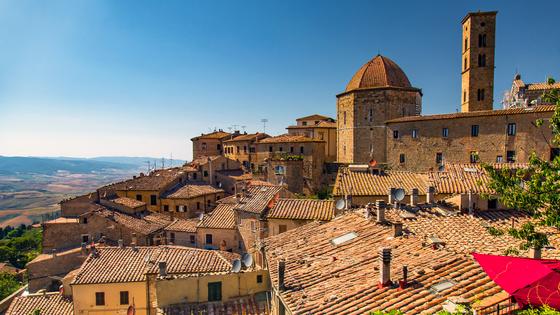Rick Steves’ Europe: Volterra and San Gimignano are two sides of Northern Tuscany
I’m in Volterra, my favorite hill town in Tuscany, sitting under rustic, noble stones at the base of a palace that made commoners feel small six centuries ago. Bats burst through the floodlights amid ghostly towers held together with rusted iron corsets. These stones have soul. The countless peasant backs they bent so many centuries ago gave to future generations the architectural equivalent of fine wines – something to be savored and pondered in solitary moments like this one.
Volterra and San Gimignano are two stony villages dotting the hills of northern Tuscany. Within a couple of hours of Tuscan mainstays Florence and Siena, these towns provide an emblematic but contrasting look at this famed region.
More than 2,000 years ago, Volterra was a key trading center and one of the most important Etruscan cities. (Tuscany is named after the Etruscan people, who lived here centuries before it was conquered by ancient Rome.) The city was protected by a four-mile-long wall – twice the size of the wall that encircles it today. You can still see its mighty Etruscan gate, built of massive stones of volcanic tuff.
Its Etruscan Museum is filled with precious artifacts from centuries before Christ. You'll see etched mirrors, intricately decorated pot handles, and exquisitely crafted jewelry. The museum’s extensive collection of urns – with subjects lounging as if munching grapes with the gods at some heavenly banquet – is a reminder that the Etruscans believed the afterlife could be fun.
Volterra's 800-year-old city hall claims to be the oldest in Tuscany, and clearly inspired the more famous Palazzo Vecchio in Florence. Civic palaces like these were emblems of an era when city-states were powerful. Their towers were architectural exclamation points declaring that townspeople, rather than popes and emperors, were calling the shots.
Alabaster has long been a big industry in Volterra. Softer and easier to work than marble, this translucent mineral was traditionally sliced thin to provide windows for Italy's medieval churches. At the alab’Arte shop, down the street from the Etruscan Museum, you can watch artisans at work.
Because of its alabaster heritage, Volterra attracted other types of artists, who brought with them a rich variety of crafts. On Via Porta all’Arco, or “Artisan Lane,” you’ll find book binderies and paperies, jewelry stores, and leather and bronze shops, among others.
Unlike other famous Tuscan hill towns, Volterra feels real and vibrant. On the opposite end of the spectrum is the touristy town of San Gimignano.
About midway between Siena and Florence, San Gimignano was a natural stop for pilgrims en route to Rome. Today, tourists replace pilgrims, and it can be really crowded. Locals seem fixated on tourist dollars, and much of the town’s architecture is actually faux medieval – reconstructed in the 19th-century Romantic Age with a flair for the fanciful. But San Gimignano is so photogenic and easy to visit, it remains a good stop. I find the place enchanting at night (i.e., without the crowds).
The town’s claim to fame is its series of striking towers. In medieval times, rich people fortified their homes by building towers, which provided a handy refuge when ruffians and rival city-states would sack the town. Pointy skylines like San Gimignano's used to be the norm in Tuscany.
Visitors enter the town through the main gate, Porta San Giovanni. The traffic-free cobbled main drag leads to Piazza della Cisterna, named for the cistern that supplied the old well in the middle of the square. Rustic-yet-proud facades crowd in a tight huddle around the well. This has been the center of town for a thousand years and it's still the place to hang out.
Farther along, on the main square, are twin 13th-century towers – among the first in town. The Civic Museum is worth a stop for its festive frescoes, classy painting collection, and 200-foot tower, which rewards climbers with commanding views and its delightful stony loggia. To see how the towers in San Gimignano were built, visit the nearby Campatelli Tower House (which also offers an excellent history of the area) and peer up its tower through a cutaway staircase and floor.
Of the town’s original 72 towers, 14 survive. When San Gimignano fell under the realm of regional bully Florence, most of the towers were torn down, and the town lost its status as a vital trade route stop. It never recovered, and poverty left it stuck in a 14th-century time-warp. That explains San Gimignano's charm, popularity, and prosperity today.
Volterra and San Gimignano both make a good escape from big, museum-packed Florence, offering travelers an engaging mix of surprising beauty, rich history, and Italy’s rustic good life.
========
(Rick Steves (www.ricksteves.com) writes European guidebooks, hosts travel shows on public TV and radio, and organizes European tours. This column revisits some of Rick's favorite places over the past two decades. You can email Rick at rick@ricksteves.com and follow his blog on Facebook.)
©2024 Rick Steves. Distributed by Tribune Content Agency, LLC.
(c)2024 RICK STEVES DISTRIBUTED BY TRIBUNE MEDIA SERVICES, INC.














Comments